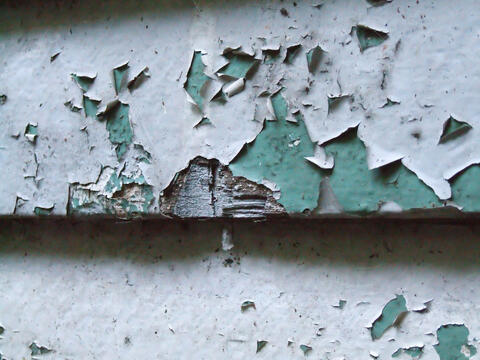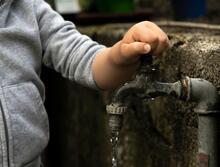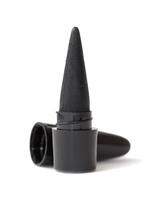Lead-Safe Wisconsin: Sources of Lead
Key information
- The only way to know if a child has been affected by lead is by getting them tested.
- Most lead-poisoned children in Wisconsin are poisoned by lead paint and lead dust.
- Regular home cleaning and maintenance can protect children from lead.
- Your Local Health Department can provide you with local lead testing and care options.
Lead is a toxic metal.
Until recently, companies commonly used lead in paint, plumbing materials, gasoline, and household products. The United States now bans or limits lead in these products, but lead is still around us.
Lead can be in the old paint, dust, pipes, and soil in or around older homes and buildings. Products like toys, pottery, and makeup from other countries can also contain lead. Risks also exist for some jobs and hobbies.
To prevent lead poisoning, it is important to know how to identify a potential hazard.
You can't know if a child was exposed to or poisoned by lead just by finding it in your environment. Often, young children don't show the impacts of lead poisoning until later in life.
The only way to know if a child has been affected by lead is by getting them tested.
Common sources of lead
Lead from paint, dust, soil, and water in and around your home can be dangerous if not managed properly.
On this page, learn about potential sources of lead in:
- Paint and dust
- Soil, yards, and playgrounds
- Drinking water
- The air
- Jobs and workplaces
- Hobbies
- Consumer products
- Food
Sometimes, lead can be found in the products you buy. It's important to stay updated on product recalls.
Find information on current product recalls.
Lead-based paint and dust

In Wisconsin, exposure to lead-based paint and dust is the most common cause of lead poisoning in children.
Lead-based paint was used in homes and businesses until 1978, when it was finally banned. This means that any home built before 1978 likely contains lead paint.
Lead paint can be found on any painted surface. Common high-risk locations are:
- Bannisters.
- Door frames.
- Windowsills.
- Baseboards.
- Anything a child can access.
When lead-based paint peels, chips, or is disturbed in some way (such as during renovation or when you open a window), it creates dangerous lead dust. If you plan to do work on your own pre-1978 home, make sure you do it lead-safe. Homeowners renovate or update homes with lead paint can poison themselves and their children.
- To learn more, visit How to Make Your Home Lead-Safe.
Important note! Lead can also be found in old shellac. Just because a surface isn't painted doesn't mean it's not a hazard.
Why is lead dust so dangerous?
Even a very small amount of lead dust can poison a child. Here's why lead dust is so dangerous:
- It's invisible. You can't see, smell, or taste lead dust. It's very easy to overlook.
- It spreads easily. Lead dust settles on floors, toys, furniture, and windowsills, so it can get picked up during normal daily activities like crawling, playing, and eating.
- It harms the youngest children. Kids under 6 are most likely to put their hands and toys in their mouths. They are also still growing and developing. Their bodies absorb lead more easily than adults.
- It builds up over time. Even the smallest amount of lead dust can build up in the body and cause serious harm if a child is exposed to it frequently.
- It can come from many sources. Chipping or pealing lead paint, renovation work, contaminated soil, and lead brought home from a job can all increase lead dust levels.
Soil, yards, and playgrounds
Soil can absorb and hold onto lead for decades. In Wisconsin, lead commonly enters the soil via lead-based paint, historic use of leaded gasoline, emissions from leaded aviation fuel, or industrial emissions.

Be careful when playing outside. Children playing in bare dirt or gardens could get exposed to lead. This happens when they touch or accidentally consume lead-contaminated soil.
The only way to know if your soil is contaminated with lead is to test it.
The U.S. Environmental Protection Agency (EPA) defines a soil lead hazard as 400 parts per million (ppm) in play areas and 1,200 ppm average for bare soil in the rest of the yard.
Learn more here: Protect Your Family from Sources of Lead
Drinking water

Lead in drinking water commonly comes from lead pipes, plumbing, or fixtures. Homes built before 1986 are most at-risk of having lead plumbing materials. That said, fixtures like faucets could have contained up to 8% lead by weighted average until 2014. In 2014, the allowable amount was lowered to 0.25% lead by weighted average.
Even if water looks, smells, and tastes clean, if may still carry lead. The longer water sits in pipes without running, the more lead it can pick up. Because of this, infants who drink formula mixed with unfiltered tap water are at higher risk for lead exposure.
There are many ways to make your drinking water safer. To learn more, visit How to Make Your Home Lead-Safe.
More resources:
Are you a licensed child care provider? We currently offer free lead-in-water testing and plumbing remediation for licensed child care and Head Start facilities.
Learn more on the Lead-in-Water Testing and Remediation Initiative webpage.
The air
Lead can be released into the air through several industrial and environmental processes. These include:
Aviation fuel. Some small airplanes with piston engines use leaded aviation gasoline ("avgas"). When these planes fly, they release lead into the air through their exhaust.
- Not all aircraft use aviation fuel. Most commercial jets and newer piston-engine planes use unleaded alternatives. People who live or work near general aviation airports, however, may have a higher chance of lead exposure. This is especially true if they live downwind or within about a mile of regular small-plane traffic.
- Learn more from the Federal Aviation Administration (FAA) about Leaded Aviation Fuel and the Environment
- Learn more from the Environmental Protection Agency about Regulations for Lead Emissions from Aircraft
Metal smelting and battery recycling. Facilities that melt, process, or recycle metals (such as lead or lead-acid batteries) can emit lead dust and fumes if not properly controlled.
Demolition or sanding of lead-painted buildings can release large amounts of lead dust into the air.
Burning buildings with lead paint can release lead dust into the air. Wildfires that reach urban areas can do the same. The resulting smoke and ash contain lead particles that can spread far beyond the burn site.
- Burning is never a safe or approved method for removing lead-based paint.
Past use of leaded gasoline. Although leaded gasoline for case was banned decades ago, lead that settled along roadways can still be re-suspended into the air as dust when soil is disturbed or blown by wind.
Coal and industrial combustion. Coal and some other fuels naturally contain small amounts of lead, which can enter the air when burned. In the United States, emissions are now much lower due to modern pollution controls.
Learn more about Basic Information about Lead Air Pollution (EPA).
Jobs and workplaces
Parents or caregivers who work around lead—such as in construction, painting, plumbing, battery manufacturing, or metalwork—can accidentally bring lead dust home on their clothes and skin.
Even if a child never steps foot on a job site, they can still be exposed.
Young children can come into contact with this dust by:
- Sitting on a caregiver's lap before they've showered or changed.
- Playing on contaminated floors or furniture.
- Touching work clothes, gear, or bags stored at home.
Don't expose a child to dangerous lead dust. Here are some actions that you can take to avoid bringing lead dust into your home:
- Change your clothes and shoes before leaving work.
- Shower at work, if possible, or immediately after arriving home.
- Keep your work gear out of living areas.
- Never wash your work clothes with family laundry.
Concerned about lead exposures on the job?
More resources and testing information are available through the Adult Lead Program.
Submit an anonymous complaint if you see lead-related work being done poorly or incorrectly.

Hobbies
Some hobbies involve direct handling of materials containing lead, such as:
- Stained glass.
- Pottery.
- Bullet casings.
- Lead fishing sinkers.
Children in homes where these hobbies take place may be exposed to lead. Exposure can happen through shared surfaces, tools, or dust.
Don't expose yourself or a child to lead. Here are some actions that you can take to avoid exposing yourself or a child to lead:
- Never put leaded materials (such as fishing sinkers or pottery glazes) in your mouth.
- Use proper ventilation and equipment when melting lead to cast your own bullets, sinkers, decoys, or metal items.
- Keep all work and hobby materials away from living areas.
For more information, visit:
- About Lead in Jobs, Hobbies, or Other Activities - CDC (Centers for Disease Control and Prevention)
- Lead in Venison
Consumer products
Sometimes, lead can be found in the products you buy. Most commonly, lead is found in products imported from outside of the United States. Lead can also be found in vintage or antique items passed down through generations.
Some toys, especially those that are imported or antique, may contain lead. Biting or swallowing toys or toy jewelry that contains lead can cause a child to become lead poisoned.
The use of lead in plastics has not been banned. Lead is used to soften plastic and to make it more flexible. Lead may be used in plastic toys. When plastic becomes brittle or breaks down due to exposure to sunlight, air, or detergents, it can form lead dust.
The Consumer Product Safety Improvement Act of 2008 lowered the lead limit for toys. Toys made before 2009 may contain more lead.
Learn more about lead in toys:

Lead has been found in products commonly used as traditional or ceremonial cosmetics.
- Kajal, kohl, surma, al-kahal, tiro, tozali, or kwalli. Traditional eye cosmetics used in some South Asian, Middle Eastern, and African cultures.
- Sindoor. Traditionally, Hindu and some Sikh women wear the red sindoor powder in the parting of their hair to indicate marital status.
Learn more about lead in cosmetics:
- Lead in Cosmetics (FDA)
- Limiting Lead in Lipstick and Other Cosmetics (FDA)
- About Lead in Foods, Cosmetics, and Medicines (CDC)
- Lead in Imported Products (Minnesota Department of Health)
- Heavy Metals in Cultural Products (EPA)
Lead has been found in powders and tablets given for arthritis, infertility, upset stomach, menstrual cramps, colic, and other illnesses. These remedies were traditionally used by East Indian, Indian, Middle Eastern, West Asian, West African, and Hispanic cultures.
| Medicine name(s) | Country or culture of origin | Usage |
|---|---|---|
| Ba-baw-san | China | Used to treat colic pain or to pacify young children. |
| Daw Tway | Thailand, Myanmar (Burma) | Digestive aid. |
| Greta, azarcon | Hispanic | Taken for upset stomach (empacho), constipation, diarrhea, and vomiting. Can be used for teething babies. |
| Ghasard | India | Tonic. |
| Calabash chalk (nzu, poto, ndom, mabele, argile, la craie) | West Africa | Used to treat morning sickness during pregnancy. |
| Pay-loo-ah | Southeast Asia | Used to treat children with rash or high fever. |
For more about lead in medicines and folk remedies, visit:
- Learn About Lead in Folk Remedies (New York Health Department)
- About Lead in Foods, Cosmetics, and Medicines (CDC)
- Lead in traditional and complementary medicine: a systematic review
- Lead in Imported Products (Minnesota Department of Health)
- Heavy Metals in Cultural Products (EPA)
Certain imported cookware has been found to leach significant levels of lead into food. The most common types of lead-leaching cookware are made from aluminum, brass, and aluminum alloys such as Hinalium/Hindolium and Indalium/Indolium.
Visit the FDA site to stay up-to-date on recalls of imported cookware
Antique or vintage cookware or dishware can also contain lead. Take care when purchasing products from thrift stores, flea markets, garage sales, antique shops, estate sales, or online. Items passed down through generations, such as family heirlooms, are also more likely to contain lead.
Common antique and vintage items that contain lead are:
- Vintage dishware
- Painted tin
- Ceramic items and ceramic glaze
Lead from these items can leach into food and drinks.
To learn more about lead in cookware, visit:
- Lead in Imported Products (Minnesota Department of Health)
- Letter to Retailers and Distributors of Cookware (FDA)
- About Lead in Consumer Products (CDC)
Lead in jewelry
Lead is commonly used in jewelry, including children's jewelry. This can be to make the product heavier or to brighten colors. It also makes it easier to shape and form. Jewelry made in the United States is less likely to contain lead. Jewelry purchased or imported from abroad has an increased risk of containing lead.
Children that chew on, suck on, or swallow jewelry that contains lead are at a high risk of lead poisoning. For this reason, children should not be allowed to wear jewelry that contains lead.
Lead in amulets
In some cultures, it is a custom to give children amulets (sheesa, tabiz, or other metal charms.) These may be for luck, protection, religion, or fashion. Lead has been found in many of these amulets, especially those from Southeast Asia.
It is important to keep charms or amulets that contain lead away from children.
To learn more about lead in jewelry and amulets, visit:
- About Lead in Consumer Products (CDC)
- Lead in Imported Products (Minnesota Department of Health)
- Lead Poisoning of a Child Associated with Use of a Cambodian Amulet (CDC)
- Lead-Free NYC: Jewelry, Amulets & Toys
- Lead in Jewelry FAQs (CA DTSC)
Food
It's not common for lead to be found in food products, but occasional recalls show that it can happen. When lead is in food, it generally affects young children the most.
It's important to stay up to date on product recalls.
Find information on current product recalls.
Multiple cinnamon products, including some bulk cinnamon sold in stores or used in flavored snacks, were found to contain unsafe levels of lead.
- Learn more here: FDA Public Health Alert: Ground Cinnamon Product.
Lead in applesauce pouches: Several brands were recalled because of lead-contaminated cinnamon.
- Learn more here: Elevated Lead & Chromium Levels: Cinnamon Applesauce Pouches.
Shooting deer with lead bullets can leave behind tiny lead fragments in the meat. These lead fragments can be distributed throughout the meat during processing and may be too small to feel or see.
Limit eating venison that was shot with lead bullets if you or your child is in an at-risk group. At-risk ground include children under 6 or pregnant women.
Learn more about lead in venison:
Lead can be found in some imported spices. In particular, lead has been found in spices from Georgia, Bangladesh, Pakistan, Nepal, and Morocco. Please take care before purchasing spices from these places or consuming spices imported from these places.
To learn more about lead in imported spices
Questions?
Reach out to Wisconsin's Childhood Lead Poisoning Prevention Program.
